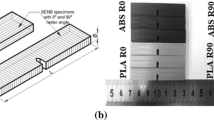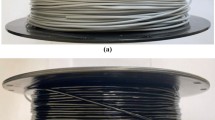Abstract
A comprehensive understanding of process–structure–property relationship of 3D printed parts is currently limited. In the present study, we investigate the influence of the mesostructure on the overall mechanical behavior of the parts synthesized via fused filament fabrication. In particular, characterization of anisotropic behavior is carefully studied by performing mechanical testing on the printed parts. The printed parts are treated as laminates and are characterized using laminate mechanics. Test coupons of thick layered and also thin layered unidirectional as well as bidirectional laminates are printed with polymeric material for tensile and bending tests. Test results revealed that the process parameters govern the mesostructure and therefore the material behavior of the parts. Mechanical behavior of the bidirectional printed laminates is studied in detail. The properties are significantly influenced by the layer thickness and layup order of the printed parts. Mechanical behavior of the printed parts can be characterized using laminate theory. The effect of lamina layup and layer thickness on the flexural properties of the laminates is significant. Furthermore, the first ply failure theory is employed for the finite element failure analysis of the printed parts. The results provide insights in the relationship between mesostructure–mechanical properties of the printed parts.









Similar content being viewed by others
Abbreviations
- L :
-
Length of specimen
- W :
-
Width of specimen
- T :
-
Thickness of specimen
- TL :
-
Tab length
- l :
-
Span length of specimen
- θ° :
-
Raster angle (Fiber angle, printing direction)
- t :
-
Layer(lamina) thickness of specimen (t1 or t2)
- E 1 :
-
Young’s Modulus of lamina in direction 1
- E 2 :
-
Young’s Modulus of lamina in direction 2
- G 12 :
-
Shear modulus of lamina in plane 1–2
- ν 12 :
-
Poisson’s ratio
- X t :
-
Longitudinal strength of lamina in tension
- Y t :
-
Transverse strength of lamina in tension
- S :
-
Inplane shear strength of lamina
- E x :
-
Young’s modulus of laminate in direction x
- U t :
-
Ultimate tensile strength of laminate
- ε t :
-
Strain to failure of laminate
- σ ply :
-
Principal stress of lamina
- ε ply :
-
Elastic strain of lamina
- E f x :
-
Flexural stiffness of laminate in direction x
- U f x :
-
Flexural strength of laminate in direction x
References
Gao W, Zhang Y, Ramanujan D et al (2015) The status, challenges, and future of additive manufacturing in engineering. Comput Des 69:65–89
Quan Z, Wu A, Keefe M, Qin X, Yu J, Suhr J, Byun JH, Kim BS, Chou TW (2015) Additive manufacturing of multi-directional preforms for composites: opportunities and challenges. Mater Today 1;18(9):503–12
Ahn SH, Montero M, Odell D, Roundy S, Wright PK (2002) Anisotropic material properties of fused deposition modeling ABS. Rapid Prototyp J 8(4):248–257
Jiang D, Smith DE (2017) Anisotropic mechanical properties of oriented carbon fiber filled polymer composites produced with fused filament fabrication. Addit Manuf 18:84–94
Guessasma S, Belhabib S, Nouri H, Hassana OB (2016) Anisotropic damage inferred to 3D printed polymers using fused deposition modelling and subject to severe compression. Eur Polym J 85:324–340
Torrado AR, Roberson DA (2016) Failure analysis and anisotropy evaluation of 3D printed tensile test specimens of different geometries and print raster patterns. J Fail Anal Prev 16(1):154–164
Wu W, Geng P, Li G, Zhao D, Zhang H, Zhao J (2015) Influence of layer thickness and raster angle on the mechanical properties of 3D-printed PEEK and a comparative mechanical study between PEEK and ABS. Materials. 8(9):5834–5846
Popescu D, Zapciu A, Amza C, Baciu F, Marinescu R (2018) FDM process parameters influence over the mechanical properties of polymer specimens: a review. Polym Test 69:157–166
Cantrell JT, Rohde S, Damiani D et al (2017) Experimental characterization of the mechanical properties of 3D-printed ABS and polycarbonate parts. Rapid Prototyp J 23(4):811–824
Zaldivar RJ, Witkin DB, McLouth T, Patel DN, Schmitt K, Nokes JP (2017) Influence of processing and orientation print effects on the mechanical and thermal behavior of 3D-printed ULTEM® 9085 material. Addit. Manuf. 13:71–80
Somireddy M, Czekanski A, Singh CV (2018) Development of constitutive material model of 3D printed structure via FDM. Mater Today Commun 15:143–152
Türk DA, Brenni F, Zogg M, Meboldt M (2017) Mechanical characterization of 3D printed polymers for fiber reinforced polymers processing. Mater Des 118:256–265
Chacón JM, Caminero MA, García-Plaza E, Núñez PJ (2017) Additive manufacturing of PLA structures using fused deposition modelling: effect of process parameters on mechanical properties and their optimal selection. Mater Des 124:143–157
Kulkarni P, Dutta D (1999) Deposition strategies and resulting part stiffnesses in fused deposition modeling. J Manuf Sci Eng 121(1):93–103
Casavola C, Cazzato A, Moramarco V, Pappalettere C (2016) Orthotropic mechanical properties of fused deposition modelling parts described by classical laminate theory. Mater Des 90:453–458
Somireddy M, Czekanski A (2017) Mechanical characterization of additively manufactured parts by FE modeling of mesostructure. J Manuf Mater Process 1(2):18
Domingo-Espin M, Puigoriol-Forcada JM, Garcia-Granada AA et al (2015) Mechanical property characterization and simulation of fused deposition modeling Polycarabonate parts. Mater Des 83:670–677
Arbeiter F, Spoerk M, Wiener J, Gosch A, Pinter G (2018) Fracture mechanical characterization and lifetime estimation of near-homogeneous components produced by fused filament fabrication. Polym Test 66:105–113
Spackman CC, Frank CR, Picha KC, Samuel J (2016) 3D printing of fiber-reinforced soft composites: process study and material characterization. J Manuf Process 23:296–305
Rankouhi B, Javadpour S, Delfanian F, Letcher T (2016) Failure analysis and mechanical characterization of 3D printed ABS with respect to layer thickness and orientation. J Fail Anal Prev 16(3):467–481
Aliheidari N, Tripuraneni R, Ameli A, Nadimpalli S (2017) Fracture resistance measurement of fused deposition modeling 3D printed polymers. Polym Test 60:94–101
Holzmond O, Li X (2017) In situ real time defect detection of 3D printed parts. Addit Manuf 17:135–142
Bartlett JL, Heim FM, Murty YV, Li X (2018) In situ defect detection in selective laser melting via full-field infrared thermography. Addit Manuf. 24:595–605
Goh GD, Dikshit V, Nagalingam AP et al (2018) Characterization of mechanical properties and fracture mode of additively manufactured carbon fiber and glass fiber reinforced thermoplastics. Mater Des 137:79–89
Ferreira RTL, Amatte IC, Dutra TA, Bürger D (2017) Experimental characterization and micrography of 3D printed PLA and PLA reinforced with short carbon fibers. Compos Part B Eng 124:88–100
Ziemian CW, Ziemian RD, Haile KV (2016) Characterization of stiffness degradation caused by fatigue damage of additive manufactured parts. Mater Des 109:209–218
Croom BP, Xu P, Lahoda EJ et al (2017) Quantifying the three-dimensional damage and stress redistribution mechanisms of braided SiC/SiC composites by in situ volumetric digital image correlation. Scr Mater 130:238–241
Croom B, Wang WM, Li J, Li X (2016) Unveiling 3D deformations in polymer composites by coupled micro x-ray computed tomography and volumetric digital image correlation. Exp Mech 56:999–1016
Zhang W, Cotton C, Sun J, Heider D, Gu B, Sun B, Chou TW (2018) Interfacial bonding strength of short carbon fiber/acrylonitrile-butadiene-styrene composites fabricated by fused deposition modeling. Compos. Part B Eng. 137:51–59
Song Y, Li Y, Song W et al (2017) Measurements of the mechanical response of unidirectional 3D-printed PLA. Mater Des 123:154–164
Alaimo G, Marconi S, Costato L, Auricchio F (2017) Influence of meso-structure and chemical composition on FDM 3D-printed parts. Compos Part B Eng 113:371–380
Islam MS, Prabhakar P (2017) Interlaminar strengthening of multidirectional laminates using polymer additive manufacturing. Mater Des 133:332–339
Tekinalp HL, Kunc V, Velez-Garcia GM et al (2014) Highly oriented carbon fiber-polymer composites via additive manufacturing. Compos Sci Technol 105:144–150
Koch C, Van Hulle L, Rudolph N (2017) Investigation of mechanical anisotropy of the fused filament fabrication process via customized tool path generation. Addit Manuf. 16:138–145
Jones RM (1999) Mechanics of composite materials. Taylor & Francis, Philadelphia
Talreja R, Singh CV (2012) Damage and failure of composite materials. Cambridge University Press, Cambridge
Acknowledgments
The authors would like to acknowledge Mr. Carrick for his assistance during the research. The grants provided by Lassonde School of Engineering and NSERC are thankfully acknowledged.
Author information
Authors and Affiliations
Corresponding author
Additional information
Publisher’s Note
Springer Nature remains neutral with regard to jurisdictional claims in published maps and institutional affiliations.
Appendix A
Appendix A
Classical Laminate Theory
The constitutive relation of a lamina is written as
where
Strains of the laminate is written as
where {ε0} are in-plane strains; {k}are curvatures of the laminate; z is distance from mid plane in the thickness direction. The constitutive matrix for a lamina in global coordinate system is given as
where \( {\overline{Q}}_{ij} \) is written as\( \left[\overline{Q}\right]={\left[T\right]}^{-1}\left[Q\right]{\left[T\right]}^{-T} \)and [T] is a transformation matrix. The resultant force and moment per unit width for a laminate with N number of layers are expressed as
Using (equation (3), (4)), and (equation (5), (6)) become
where \( \left[A\right]=\sum \limits_{k=1}^N{\left[\overline{Q}\right]}_k\left({z}_k-{z}_{k-1}\right) \), \( \left[B\right]=\frac{1}{2}\sum \limits_{k=1}^N{\left[\overline{Q}\right]}_k\left({z}_k^2-{z}_{k-1}^2\right) \), \( \left[D\right]=\frac{1}{3}\sum \limits_{k=1}^N{\left[\overline{Q}\right]}_k\left({z}_k^3-{z}_{k-1}^3\right) \).
The [A], [B] and [D] are stiffness matrices for the laminate. The [B] = [0] for a symmetric laminate. The mid-plane strains and curvatures can be calculated from (equation (7), (8)), once we know the normal force and moment acting on a lamina. Strains for a symmetric laminate subjected to only in-plane forces are given from (equation (7)) as
Strains for a symmetric laminate subjected to only transverse loads are given from (equation (8)) as
Uniaxial tensile loading along x-axis: In the uniaxial tensile test, the load is applied in the x direction and for laminate thickness h, Nxx = hσxxNyy = 0 and Nxy = 0. The stress-strain relation for uniaxial tensile test is \( {\sigma}_{xx}={E}_{xx}{\varepsilon}_{xx}^0 \), using the relation (equation (9)), the modulus of elasticity along the x direction of the laminate is calculated as follows
Flexural loads: In the 3-point bending test, the load is applied in the z direction and for laminate thickness h, Mxx ≠ 0, Myy = 0 and Mxy = 0. The relationship between flexural stress and stiffness is written as \( {E}_x^f={\sigma}_{xx}^f/{\varepsilon}_{xx}^f \), using the (equation (10)), the flexural modulus of elasticity of the laminate along the x direction is given as follows
The elastic moduli such as E1, E2, G12, ν12 of the lamina found from the experimental tensile test results are used for the calculation of matrices [A], [B] and [D]. Then, Exx and \( {E}_x^f \)of the laminate can be calculated using (equation (11), (12)), respectively. More details about the laminate theory available in [35].
Tsai-Hill Failure Criterion
The failure criterion for a planar stress is written as
The lamina properties available in Table 3 are useful in the failure analysis of the printed laminates. The nonlinear quasi-static finite element failure analysis of the laminates was done in Hyperworks. The first ply failure stresses and corresponding strains are reported in the results when the laminate just met the failure criterion. More details about the nonlinear quasi static analysis and finite element modeling of composites laminates can be found in the Hyperworks manual.
Rights and permissions
About this article
Cite this article
Somireddy, M., Singh, C.V. & Czekanski, A. Analysis of the Material Behavior of 3D Printed Laminates Via FFF. Exp Mech 59, 871–881 (2019). https://doi.org/10.1007/s11340-019-00511-5
Received:
Accepted:
Published:
Issue Date:
DOI: https://doi.org/10.1007/s11340-019-00511-5




